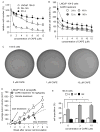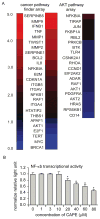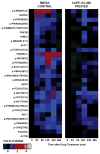Caffeic acid phenethyl ester suppresses the proliferation of human prostate cancer cells through inhibition of p70S6K and Akt signaling networks
- PMID: 22562408
- PMCID: PMC4962698
- DOI: 10.1158/1940-6207.CAPR-12-0004-T
Caffeic acid phenethyl ester suppresses the proliferation of human prostate cancer cells through inhibition of p70S6K and Akt signaling networks
Abstract
Caffeic acid phenethyl ester (CAPE) is a bioactive component derived from honeybee hive propolis. CAPE has been shown to have antimitogenic, anticarcinogenic, and other beneficial medicinal properties. Many of its effects have been shown to be mediated through its inhibition of NF-κB signaling pathways. We took a systematic approach to uncover the effects of CAPE from hours to days on the signaling networks in human prostate cancer cells. We observed that CAPE dosage dependently suppressed the proliferation of LNCaP, DU-145, and PC-3 human prostate cancer cells. Administration of CAPE by gavage significantly inhibited the tumor growth of LNCaP xenografts in nude mice. Using LNCaP cells as a model system, we examined the effect of CAPE on gene expression, protein signaling, and transcriptional regulatory networks using micro-Western arrays and PCR arrays. We built a model of the impact of CAPE on cell signaling which suggested that it acted through inhibition of Akt-related protein signaling networks. Overexpression of Akt1 or c-Myc, a downstream target of Akt signaling, significantly blocked the antiproliferative effects of CAPE. In summary, our results suggest that CAPE administration may be useful as an adjuvant therapy for prostate and potentially other types of cancers that are driven by the p70S6K and Akt signaling networks.
Figures






Similar articles
-
CAPE suppresses migration and invasion of prostate cancer cells via activation of non-canonical Wnt signaling.Oncotarget. 2016 Jun 21;7(25):38010-38024. doi: 10.18632/oncotarget.9380. Oncotarget. 2016. PMID: 27191743 Free PMC article.
-
Caffeic acid phenethyl ester suppresses the expression of androgen receptor variant 7 via inhibition of CDK1 and AKT.Cancer Gene Ther. 2024 Jun;31(6):807-815. doi: 10.1038/s41417-024-00753-z. Epub 2024 Mar 13. Cancer Gene Ther. 2024. PMID: 38480977
-
Caffeic acid phenethyl ester induced cell cycle arrest and growth inhibition in androgen-independent prostate cancer cells via regulation of Skp2, p53, p21Cip1 and p27Kip1.Oncotarget. 2015 Mar 30;6(9):6684-707. doi: 10.18632/oncotarget.3246. Oncotarget. 2015. PMID: 25788262 Free PMC article.
-
The anticancer mechanism of caffeic acid phenethyl ester (CAPE): review of melanomas, lung and prostate cancers.Eur Rev Med Pharmacol Sci. 2012 Dec;16(15):2064-8. Eur Rev Med Pharmacol Sci. 2012. PMID: 23280020 Review.
-
Caffeic Acid phenethyl ester is a potential therapeutic agent for oral cancer.Int J Mol Sci. 2015 May 12;16(5):10748-66. doi: 10.3390/ijms160510748. Int J Mol Sci. 2015. PMID: 25984601 Free PMC article. Review.
Cited by
-
The DIONESUS algorithm provides scalable and accurate reconstruction of dynamic phosphoproteomic networks to reveal new drug targets.Integr Biol (Camb). 2015 Jul;7(7):776-91. doi: 10.1039/c5ib00065c. Integr Biol (Camb). 2015. PMID: 26057728 Free PMC article.
-
Molecular and cellular mechanisms of the effects of Propolis in inflammation, oxidative stress and glycemic control in chronic diseases.Nutr Metab (Lond). 2020 Aug 12;17:65. doi: 10.1186/s12986-020-00485-5. eCollection 2020. Nutr Metab (Lond). 2020. PMID: 32817750 Free PMC article.
-
Recent progress of propolis for its biological and chemical compositions and its botanical origin.Evid Based Complement Alternat Med. 2013;2013:697390. doi: 10.1155/2013/697390. Epub 2013 Apr 30. Evid Based Complement Alternat Med. 2013. PMID: 23737843 Free PMC article.
-
Caffeic acid phenethyl ester (CAPE) confers wild type p53 function in p53Y220C mutant: bioinformatics and experimental evidence.Discov Oncol. 2021 Dec 20;12(1):64. doi: 10.1007/s12672-021-00461-2. Discov Oncol. 2021. PMID: 35201513 Free PMC article.
-
Histone Demethylase KDM4C Stimulates the Proliferation of Prostate Cancer Cells via Activation of AKT and c-Myc.Cancers (Basel). 2019 Nov 13;11(11):1785. doi: 10.3390/cancers11111785. Cancers (Basel). 2019. PMID: 31766290 Free PMC article.
References
-
- Sarker D, Reid AH, Yap TA, de Bono JS. Targeting the PI3K/AKT pathway for the treatment of prostate cancer. Clin Cancer Res. 2009;15:4799–805. - PubMed
-
- Kreisberg JI, Malik SN, Prihoda TJ, Bedolla RG, Troyer DA, Kreisberg S, et al. Phosphorylation of Akt (Ser473) is an excellent predictor of poor clinical outcome in prostate cancer. Cancer Res. 2004;64:5232–6. - PubMed
-
- Bhimani RS, Troll W, Grunberger D, Frenkel K. Inhibition of oxidative stress in HeLa cells by chemopreventive agents. Cancer Res. 1993;53:4528–33. - PubMed
Publication types
MeSH terms
Substances
Grants and funding
LinkOut - more resources
Full Text Sources
Other Literature Sources
Medical
Miscellaneous

